Rick's b.log - 2012/05/18
You are 18.221.12.61, pleased to meet you!
Rick's b.log - 2012/05/18 |
|
| It is the 21st of November 2024 You are 18.221.12.61, pleased to meet you! |
|
mailto: blog -at- heyrick -dot- eu
First, I got a build of RISC OS with the s-video port supported. It will speak PAL to the s-video port, but with some quirks (setting an unsupported mode will spew rubbish, and colours are incorrect in 32K and 16M modes). But, you know, it is a lot better than a blank screen!
The ROM archive is currently at:
Drop the "riscos" file within on to the boot microSD over top of the one you might have made yesterday. Then boot the Beagle xM (press the button if need be) and after a brief delay the bars will go away and you'll see RISC OS boot. If you're used to a RiscPC, you'll be somewhat astonished by the speed of the Beagle!
While this was going on, I was also making a case for my Beagle xM. It is a little tupperware-like box that is conveniently Beagle-sized. Here I am checking the holes are in the correct places. I'm no craftsman, the holes were designed to work, not look perfect. I got five boxes for three euros, so I can always attempt a tidier version later! Anyway, you can see the gadget I used to make the holes. I think it is for glass engraving or something. It is pretty awkward to handle, but it got the job done.
Once it was all checked, I used three blobs of glue from a hot-melt glue gun (the corners, except the one by the RS232 port) to hold the board in place. It is intended to be solid enough without the hassle of screws and such.
Now, finally, giving it a test-drive. It is really weird seeing half a gigabyte of memory on a RISC OS machine.
Of course, Real Life got in the way. Going shopping, taking the rubbish up the road to the bin...
Once RISC OS was running, it was simple (albeit a little time consuming) to create the default boot harddisc as described here (under "Putting the HardDisc4 image onto a USB drive" subsection "If you don’t have an existing RISC OS device with USB support".
Essentially, a USB device was formatted FAT and the self-extracting archive and a setup script were placed upon in. Under RISC OS, this device was mounted and the setup script extracted the files to RAMdisc. The USB device was then formatted to ADFS format. The files were then copied to the newly formatted device and it was dismounted to ensure changes correctly written out. Job done.
Notes:
Upon reboot, and with the full boot working, the display was washed out. Press F12 and type:
We can do something about this. Download this file (should be a text file called "BeagleMDF") and place it into !Boot.Resources.Configure.Monitors.Beagle (creating the Beagle subfolder).
This mode definition provides the following modes:
Here's an example of 640×480:
And here's 702×552 (this was offered in an older version of the BeagleMDF and is no longer available):
And here's 720×576 (UPDATE! - this replaces the 702×552 mode):
Once I had the machine set up, I used
What I have done now is erase the file "user.txt" from yesterday. The file "uEnv.txt" was then renamed "user.txt". This means booting up with the user button held down will start Angstrom Linux.
I named the CMOS RAM file "rocmos" and placed a copy on the microSD card [you can download a premade copy], and then created a new uEnv.txt file which looks like this:
So... there you have it. RISC OS on a Beagle xM with s-video output. I'll do some fiddling/hacking another time, but for now, the latest Sankarea has arrived. ☺
Beagle xM - RISC OS working!
It's been a busy day.
[you gotta pause for a moment to enjoy that domain name! "egnufeb"&>:#,_@ - is it PERL or something?]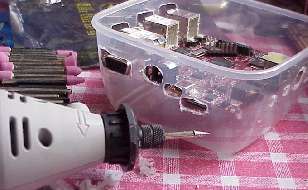
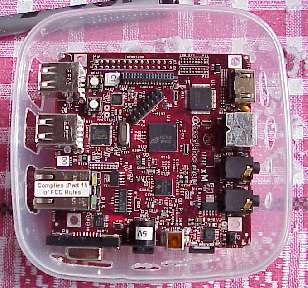
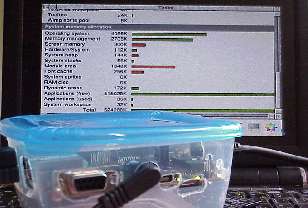

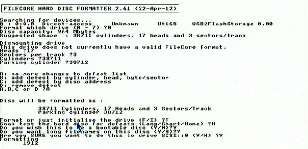
Anything larger, and DOSFS will choke, potentially corrupting data on the drive.
and press Return to go back to the desktop, this time in something more visible.
*WimpMode 28
Then, in the Monitor configuration (double-click !Boot to start the configuration utility), select the monitor Beagle S-video, as shown:
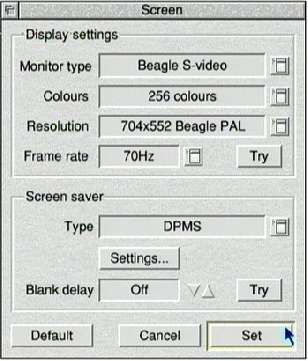

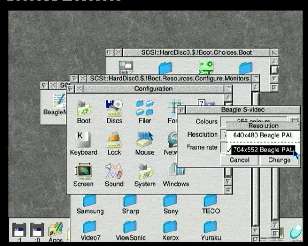
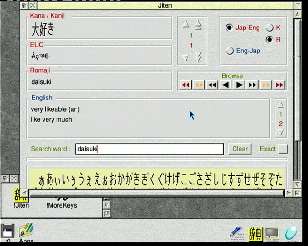
*SaveCMOS to write a copy of the CMOS RAM (RISC OS term for NVRAM) to a FAT formatted USB device (a second USB drive). This was so I could copy it to the boot microSD card.
This means RISC OS will load as the default operating system.
mpurate=1000
defaultdisplay=tv
optargs="consoleblank=0"
console="tty0 console=ttyS2,115200n8"
uenvcmd=mmcinit;fatload mmc 0:1 0x8100f800 rocmos;fatload mmc 0:1 0x81000000 riscos;go 0x81000000
note - the "uenvcmd" and everything that follows is all one line; it may be wrapped on your display
[download a copy]
joe, 19th May 2012, 09:42
than paying around $30.00 for specially designed box.
I've made mine out of a small junction box, from local
electronics shop at about $6.00, have to modify the top lead to see what is going on inside the box.Keith Dunlop, 19th May 2012, 20:30
I don't know if you've tried it yet but get ahold of those famous artworks files (the midget, the acorn etc.) and you will be shocked to see how fast they render.
They are a favourite of mine when I am demonstrating just how fast a RISC OS computer can be these days - at Wakefield this year I was demonstrating a PandaBoard running at 1.5GHz.
Scary x86 alike numbers aren't they (it has 1GB of RAM!!!)?
You'll find disc access is slow as it is over USB so put !Scrap into a RAMdisc - I recommend memphis as it can give upto 256MB space.
Have fun and enjoy :-DPatric, 20th May 2012, 10:07 Colin Ferris, 20th May 2012, 13:17 Rick, 20th May 2012, 21:01
Colin - probably not, but I feel happier knowing that something has cast its eye across the disc so if there is any problem, hopefully the formatter would abort before I put data onto the device.Patric, 20th May 2012, 23:20
Quick check on ebay.fr shows several 15 & 17" Eizos within this price bracket, interestingly enough all "de Allemagne" but perhaps you could source one locally? The HannsG I mentioned was actually very good too. As long as it comes with DVI-D you'll be fine and since DVI has now been superseded by HDMI of which the Beagle doesn't make full use anyway (no audio) they tend to be cheap old stock/second hand items. Obviously you'll need a HDMI to DVI-D adapter, was ~15 quid at Maplin I think.
| © 2012 Rick Murray |
This web page is licenced for your personal, private, non-commercial use only. No automated processing by advertising systems is permitted. RIPA notice: No consent is given for interception of page transmission. |